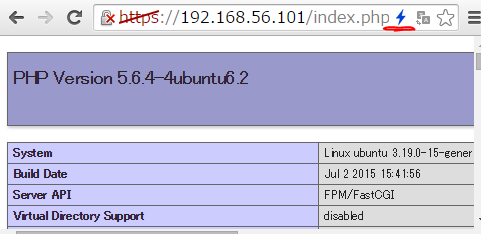関連記事:
次はPHPを動かす
ヾ(・ω<)ノ" 三三三● ⅱⅲ コロコロ♪
------------------- ↓ 余談はここから ↓-------------------
HTTP/2の動作確認はできたので、
今度はアプリケーションサーバを作ってみる。
PHP側で特に設定はいらないので、
インストールはdebianのパッケージを使用した。
リバースプロキシで受けてもいいけど、
今回はSOCK経由で受けてみようと思う。
ヾ(・ω<)ノ" 三三三● ⅱⅲ コロコロ♪
------------------- ↓ 本題はここから ↓-------------------
nginxをHTTP/2対応のサーバにPHPを入れる
HTTP/2対応のnginx構築は前回やったのでそっちを見てほしい。
PHPインストール
sudo apt-get install php5-fpm
nginxの調整
設定ファイル調整
nginx側にsockのpathを登録
http {
server {
listen 443 ssl http2;
server_name localhost;
・・・
location ~ \.php$ {
root html;
# fastcgi_pass 127.0.0.1:9000;
fastcgi_pass unix:/var/run/php5-fpm.sock;
fastcgi_index index.php;
fastcgi_param SCRIPT_FILENAME $document_root$fastcgi_script_name;
include fastcgi_params;
}
}
}
再起動
sudo /usr/local/nginx/sbin/nginx -t # 設定変更確認
sudo /usr/local/nginx/sbin/nginx -s quit # 終了
sudo /usr/local/nginx/sbin/nginx # 起動
動作確認
<?php phpinfo();
ヾ(・ω<)ノ" 三三三● ⅱⅲ コロコロ♪
------------------- ↓ 補足はここから ↓-------------------
さて、動作確認はできたので、
ここではリライト方法について考えよう。
最近のフレームワークならばURLを綺麗にする(SEOに最適なURLにする)という手法が一般的に実装されている。
対応方法はフレームワークによってまちまちであるが、
主に以下の二つだと思う。
-
クエリストリング
特定のクエリストリングをURLのパラメータとして取り込む方法 -
PATHINFO
cgiのPATHINFOをパラメータとして取り込む方法
リライト運用
クエリストリング
PHPファイルをindex.php
クエリストリングのパラメータ名をqとすると
http{
・・・
server{
listen 443 ssl http2
・・・
root html;
index index.html index.htm;
location / {
try_files = $uri $uri/ /index.php?q=$uri&$args;
}
location ~ \.php {
fastcgi_pass unix:/var/run/php5-fpm.sock;
fastcgi_index index.php;
fastcgi_param SCRIPT_FILENAME $document_root$fastcgi_script_name;
include fastcgi_params;
}
}
}
PATHINFO
PHPファイルをindex.phpとすると
http{
・・・
server{
listen 443 ssl http2
・・・
root html;
index index.html index.htm;
location / {
try_files = $uri $uri/ /index.php$uri?$args;
}
location ~ [^/]\.php(/|$) {
fastcgi_split_path_info ^(.+?\.php)(/.*)$;
fastcgi_pass unix:/var/run/php5-fpm.sock;
fastcgi_index index.php;
fastcgi_param SCRIPT_FILENAME $document_root$fastcgi_script_name;
include fastcgi_params;
fastcgi_param PATH_INFO $fastcgi_path_info;
}
}
}
